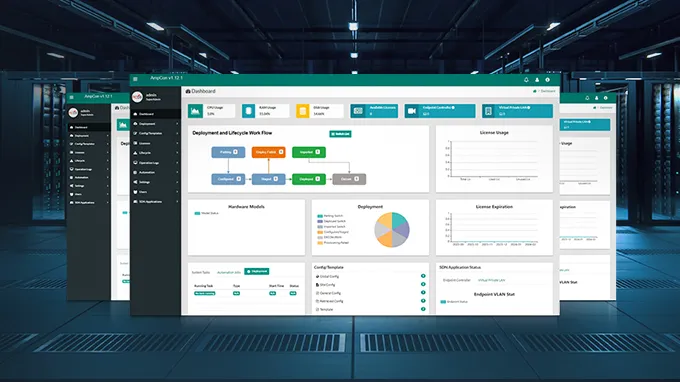Comparing Blade, Rack, and Tower Servers for Optimal Deployment
When choosing a server that meets the needs of your company, you have various options, including blade servers, rack servers, and tower servers, among others. Each type of server serves different purposes and meets specific company requirements for particular reasons. This article primarily discusses their definition, advantages, disadvantages, comparisons, and how to choose the server that suits your needs.
What Are They?
The following introduces the definitions, forms, functions, as well as the advantages and disadvantages of blade servers, rack servers, and tower servers.
Rack Server
A rack server is a versatile server housed within a rack. Typically, rack servers are designed to accommodate various applications and serve diverse computing infrastructure needs. Rack-mounted servers are designed according to uniform standards, usually installed in a rack, and can be stacked and placed in a metal casing for easy management.
Forms
-
The standard server rack dimensions are 1.75 inches high and 19 inches wide. The height can be 1U, 4U, 6U, 10U or higher.
-
The 1U rack server has a confined internal space, permitting only 1-2 PCI expansion slots. FS custom rack servers can support more accessories and card slots. For details, please check - RS3110.
Advantages
-
Enhanced reliability: Easy mobility and deployment minimize the risk of failures.
-
Streamlined cabling: In-rack management tools simplify cable organization, ensuring efficiency.
-
Cost-effective solutions: Lower costs combined with substantial computing power and efficiency.
Disadvantages
-
Power consumption: Densely populated racks demand additional cooling units, leading to increased energy expenses. A higher quantity of rack servers contributes to an overall rise in energy requirements.
-
Maintenance challenges: Densely packed racks necessitate more troubleshooting and management time, impacting overall maintenance demands.
Blade Server
A blade server is an enclosure hosting multiple modular circuit boards known as server blades. These blades typically encompass essential components like the server CPU, memory, and network controls. Although primarily focused on these modular elements, some blade servers also incorporate storage drives, facilitating network storage functionalities like SAN or NAS devices.
Advantages
-
Space-efficient design.
-
Hot-swappable for seamless deployment.
-
Efficient data cluster processing.
-
Unified interface for easy maintenance and monitoring of all blade servers.
-
Simplified setup without the need for intricate cabling.
Disadvantages
-
Initial investment: While long-term operational costs are reasonable due to simplified management interfaces and reduced energy consumption, the upfront expenses, including capital, deployment, and configuration, can be significant.
-
Energy consumption: Energy consumption: Advanced climate control is essential for high-density blade servers, resulting in additional costs for heating, cooling, and ventilation to ensure optimal performance.
Tower Server
Tower servers are essentially integrated desktop computers with a substantial footprint. As a result, they boast higher CPU power, fast read memory, and are designed to manage multi-user requests efficiently. Additionally, they offer various services, including DHCP or DNS.
Advantages
-
Upgrades and scalability: tower servers can be customized and upgraded as needed.
-
Heat dissipation: tower servers have low component density and are easy to dissipate and cool.
-
Easy heat dissipation: Tower servers, with low component density, facilitate efficient heat dissipation and cooling.
-
Versatile applications: They can meet the application requirements of common servers.
Disadvantages
-
Bulky size and space occupation.
-
Complicated server management.
-
Absence of advanced components such as high-end graphics cards and RAM.
Differences Among the Types of Servers
After familiarizing yourself with the three main types of network servers mentioned above, you now have a basic understanding of these servers. Next, let's delve into the distinctions between blade servers, rack servers, and tower servers.
Key Differences: Blade Server vs. Rack Server
|
Difference Types
|
Rack Server
|
Blade Server
|
|---|---|---|
|
Form Factor
|
|
|
|
Performance & Configuration
|
|
|
|
Heat Generation
|
|
|
Key Differences: Rack Server vs. Tower Server
|
Difference Types
|
Rack Server
|
Tower Server
|
|---|---|---|
|
Size & Application
|
|
|
|
Heat Dissipation
|
|
|
Blade Server vs. Rack Server vs. Tower Server: How to Choose Them?
To enhance data center storage and computing power, selecting an appropriate server type is crucial for on-premises infrastructure. Blade servers, rack servers, and tower servers each offer distinct advantages, as outlined above.
Business Model
For medium-to-large enterprises facing spatial constraints in their data centers but requiring multiple servers for high-end applications, opting for blade servers is an ideal deployment solution. If your data center prioritizes computing power, rack servers are a suitable choice. Conversely, for small businesses or home networks, a tower server designed for file storage and network resource deployment proves to be a more fitting option.
FS Servers
In the diverse server market, various brands offer servers with varying performance and services. FS stands out with its servers, featuring rack and tower options equipped with built-in Intel Xeon processors, ensuring faster and stronger data processing. FS caters to evolving business needs by providing pre-configured multi-function options. Additionally, FS excels in customization, allowing you to configure servers according to your network requirements, including high-performance processors, memory, hard disks, and PCIe expansion slots.
FS Service
Acquiring FS rack-mounted servers or tower servers ensures comprehensive server management, inclusive and without any additional cost. This guarantees access to a team of experts proficient in handling your servers, utilizing top-notch industry tools, best-in-class server resources, and unparalleled technical support.
Conclusion
In conclusion, blade servers, rack servers, and tower servers each offer unique advantages and features suitable for various scenarios. Rack servers are often favored by many enterprises due to their comparable computing power with tower servers. Moreover, rack servers have a relatively smaller volume than tower servers, resulting in lower cooling costs compared to blade servers. Additionally, rack servers exhibit distinctive features and show promising market prospects for the future.
You might be interested in
Email Address

-
PoE vs PoE+ vs PoE++ Switch: How to Choose?
May 30, 2024















